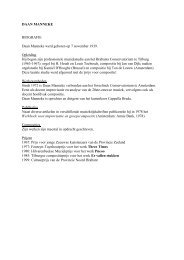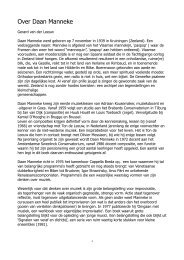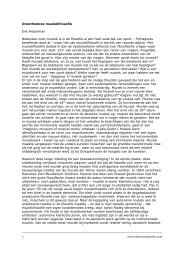Anton Webern and the influence of Heinrich Isaac
Anton Webern and the influence of Heinrich Isaac
Anton Webern and the influence of Heinrich Isaac
Create successful ePaper yourself
Turn your PDF publications into a flip-book with our unique Google optimized e-Paper software.
Op. 16 was a pre-serial work, however, <strong>and</strong> while it may have hinted at what<br />
was to come, it was with <strong>the</strong> composition <strong>of</strong> <strong>the</strong> Symphony Op. 21 <strong>and</strong> subsequent<br />
works that <strong>Webern</strong>’s exploration <strong>and</strong> exploitation <strong>of</strong> canonic technique became more<br />
pr<strong>of</strong>ound. With <strong>the</strong> new techniques <strong>of</strong> <strong>the</strong> twelve-note system effectively assimilated<br />
in Opp. 17-20 <strong>Webern</strong> was free to embark on <strong>the</strong> ambitious task <strong>of</strong> an almost entirely<br />
canonic, serial piece. Given that <strong>the</strong> ‘twelve-note technique was perceived as an<br />
inherently polyphonic method’ (Bailey, 1991:94), it might be seen as somehow<br />
tautological to apply canonic principles to it. This view is supported by Adorno who<br />
sees counterpoint in twelve-note composition as being ‘no longer distinguishable from<br />
<strong>the</strong> process <strong>of</strong> composition in general’ <strong>and</strong> <strong>the</strong>refore a ‘futile struggle’ (Bailey, 1991:<br />
113). However, while he expresses this view with negative overtones, it needn’t be<br />
seen as such, as, for <strong>Webern</strong>, ideas <strong>of</strong> unity <strong>and</strong> order – which he saw as a pre-<br />
requisite for comprehensibility – were <strong>of</strong> <strong>the</strong> utmost artistic importance. How better to<br />
achieve <strong>the</strong> highest degree <strong>of</strong> unity <strong>and</strong> order than to create a work in which <strong>the</strong><br />
compositional process is at one with basic material <strong>and</strong> <strong>the</strong> final artistic product? It<br />
seems that Adorno possibly overlooked <strong>Webern</strong>’s basic artistic purpose.<br />
It is in this purpose that we find ano<strong>the</strong>r, <strong>and</strong> possibly <strong>the</strong> most pr<strong>of</strong>oundly<br />
important, link between <strong>Webern</strong> <strong>and</strong> his beloved Ne<strong>the</strong>rl<strong>and</strong>ers. And it is in his<br />
Symphony that we find possibly his most effective realisation <strong>of</strong> this aim. That <strong>the</strong><br />
‘extreme <strong>the</strong>matic unity <strong>of</strong> his music…was consciously linked in his mind with <strong>the</strong><br />
example <strong>of</strong> <strong>the</strong> Ne<strong>the</strong>rl<strong>and</strong>s composers’ (Donat, 1972: 11) is highlighted by his<br />
comment in <strong>the</strong> 1932 lecture series Der Weg zur neuen Musik that ‘Greater unity is<br />
impossible. Even <strong>the</strong> Ne<strong>the</strong>rl<strong>and</strong>ers didn’t manage it’ (Todd, 1978: 50). He was<br />
referring to <strong>the</strong> second movement <strong>of</strong> his Symphony in which ‘nine different musical<br />
realisations <strong>of</strong> <strong>the</strong> palindrome achieve various degrees <strong>of</strong> symmetry in different<br />
9





![Schubert, Winterreise: Einsamkeit [PDF] - bestmusicteacher.com](https://img.yumpu.com/21166489/1/190x135/schubert-winterreise-einsamkeit-pdf-bestmusicteachercom.jpg?quality=85)

![Schubert, Winterreise: Die Nebensonnen [PDF] - Bestmusicteacher ...](https://img.yumpu.com/20295219/1/190x135/schubert-winterreise-die-nebensonnen-pdf-bestmusicteacher-.jpg?quality=85)
